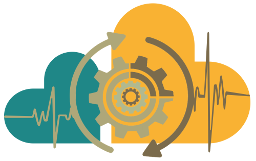Workflows
What is a Workflow?Filters
This Galaxy workflow streamlines comprehensive copy number variation (CNV) analysis by integrating CNVkit’s robust detection capabilities with an efficient conversion step using cnv-vcf2json to format results into Beacon JSON. Designed for computational biologists and bioinformaticians, the workflow standardizes CNV identification and output formatting to enhance interoperability with Beacon networks. It is specifically optimized for use with mapped BAM files from the EGAD00001008392 synthetic ...
The workflow starts with selecting KLF4 as the search term. Gene sets with set labels containing KLF4 were queried from Enrichr[1]. Identified matching terms from the ENCODE TF ChIP-seq 2015[2] library were assembled into a collection of gene sets. A GMT was extracted from the Enrichr results for ENCODE_TF_ChIP-seq_2015. Identified matching terms from the ChEA 2022[4] library were assembled into a collection of gene sets. A GMT was extracted from the Enrichr results for ChEA_2022. Identified ...
The workflow starts with selecting Autophagy as the search term. Gene sets with set labels containing Autophagy were queried from Enrichr[1]. Identified matching terms from the MGI Mammalian Phenotype Level 4 2019[2] library were assembled into a collection of gene sets. A GMT was extracted from the Enrichr results for MGI_Mammalian_Phenotype_Level_4_2019. All the identified gene sets were combined using the union set operation. Reversers and mimickers from over 1 million signatures were identified ...
The workflow starts with selecting chr10:g.3823823G>A as the search term. The closest gene to the variant was found using MyVariant.info[1]. RNA-seq-like LINCS L1000 Signatures[3] which mimick or reverse the the expression of KLF6 were visualized. Median expression of KLF6 was obtained from the GTEx Portal[8] using the portal's API. To visualize the scored tissues, a vertical bar plot was created Fig..
- Lelong, S. et al. BioThings SDK: a toolkit for building high-performance data APIs in ...
The workflow requires the user to provide:
- ENSEMBL link address of the annotation GFF3 file
- ENSEMBL link address of the assembly FASTA file
- NCBI taxonomy ID
- BUSCO lineage
- OMArk database
Thw workflow will produce statistics of the annotation based on AGAT, BUSCO and OMArk.
Workflow to download and prepare TCGA data.
The workflow divides the process of generating Gene Regulatory networks from TCGA cancer data in three steps:
- Downloading the raw data from GDC and saving the rds/tables needed later
- Preparing the data. This step includes filtering the data, normalizing it...
- Analysis of gene regulatory networks
This workflow demonstrates the integration of FAIR principles into the workflow management ecosystem through provenance integration in Autosubmit, a workflow manager developed at the Barcelona Supercomputing Center (BSC), and SUNSET (SUbseasoNal to decadal climate forecast post-processing and aSSEssmenT suite), an R-based verification workflow also developed at BSC.
Autosubmit supports the generation of data provenance information based on RO-Crate, facilitating the creation of machine-actionable ...
This workflow creates taxonomic summary tables for a specified taxonomic rank out of MAPseq's OTU tables output collection.

 Tests
Tests